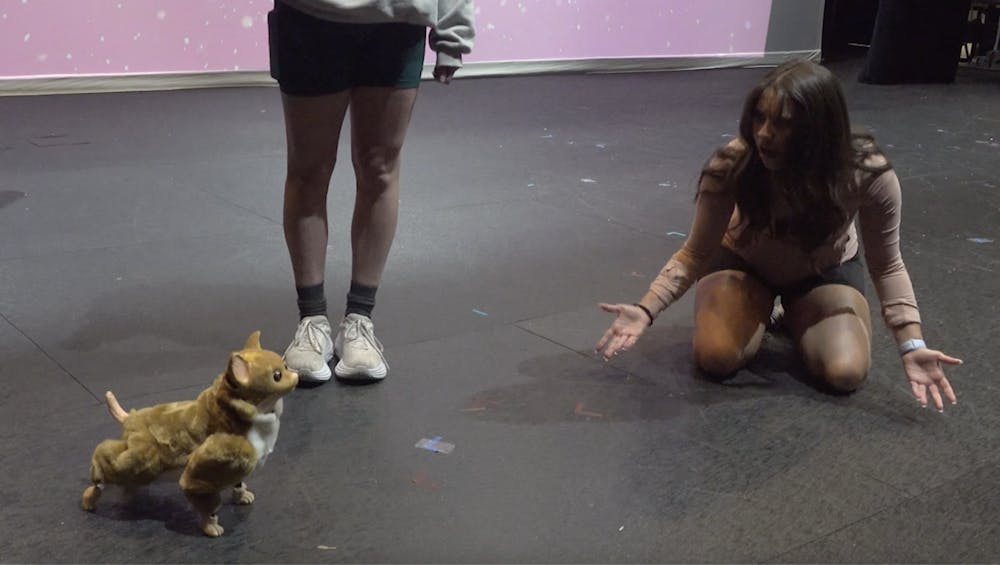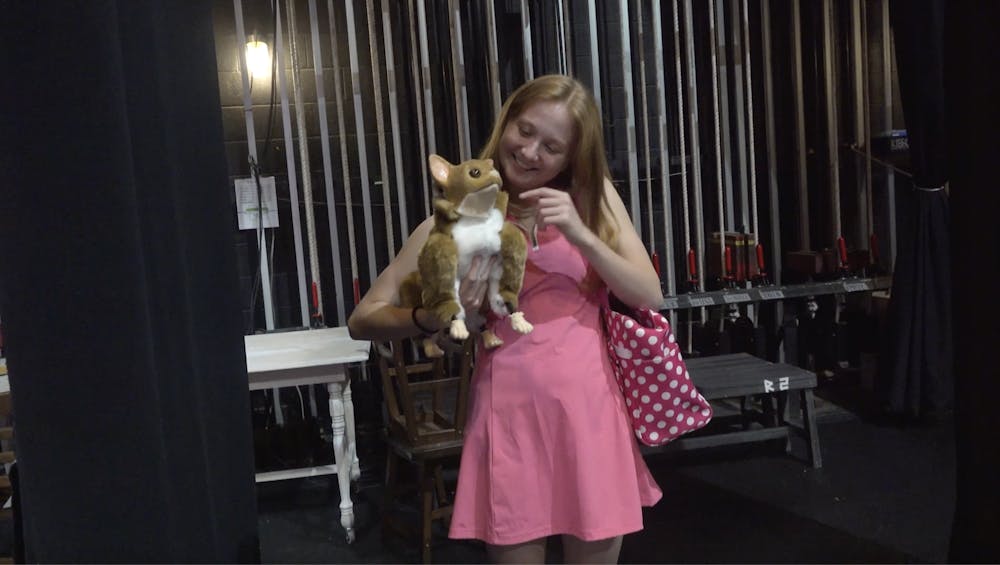Two robotic dogs are making their debut appearance during Elon University’s fall mainstage musical “Legally Blonde.”
As the production prepares for its opening Oct. 25, Elon engineering students are putting final touches on the robotic dogs, bringing the show’s beloved canine characters — Bruiser and Rufus — to life.
Senior engineering major Zoë Scherpbier said the tiny aesthetic touches are the last part of preparing the dogs for the stage, including airbrushing the fur for texture variety and shaving at the legs.
Over the past five months, engineering students have done extensive research and work to build the dogs. Scherpbier built shells of artificial fur and dog features to make the robots’ outsides as realistic as possible without falling into the uncanny valley — a psychological phenomenon when people are repulsed by what resembles a living thing but is slightly unrealistic.
“Reactions have been so much better than I was expecting,” Scherpbier said. “They’re all like, ‘Oh my god, he’s so cute.’ It warms my heart when other people can appreciate how adorable our little robots are.”
The robots are part of a Science, Technology, Engineering, Arts and Mathematics — or STEAM — project facilitated by engineering professor Blake Hament and music theatre professor Courtney Liu.
Hament and Liu originally met at Duke University as undergraduate students, but when they reunited during an Elon new professor orientation two years ago, they talked about working together on a STEAM project.
“We started kind of joking, ‘Wouldn’t it be great if we put robots in a musical?’” Hament said.
Senior music theatre major Emily Stober, who plays the lead character Elle Woods, interacts with both robotic dogs during the show. Stober said a production using robots instead of live animals or puppets was an uncommon and exciting element for the actors to adapt to.
“When they brought the first robot dog into our first rehearsal, and everyone was so taken aback, I think we were all screaming when we saw it move for the first time,” Stober said with laughter. “I was just blown away, because like so many other people, I had so many questions about what these dogs were going to be. But seeing it move for the first time, I was like, ‘Oh, this is going to be a lot of fun.’”
Stober recounted the challenges of a community theater production that used live dogs, including dogs falling into the musician’s pit and peeing on stage. She said using robots for the dogs is a happy medium between an inanimate object and a live animal.
“Even though it’s not a living thing, there’s someone controlling it, and they kind of breathe their energy into the animal,” Stober said. “It really does feel alive.”
Junior mechanical engineering major Amalie Keefe, who operates Rufus, said she’s become attached to the robot and feels passionate about it.
“I like to stand up for it when people talk about it,” Keefe said. “Some people find it scary to look at. I love my research, I love that I’m doing it, but I understand that other people are a little more wary of what I work on.”
Liu said one aspect of the research surrounding the project is how audiences will react to the robotic dogs as part of the musical, with the goal being for them to react almost as they would to a real dog.
“We want them to have the ‘aww’ factor, the ‘Oh, cuddly, I want to pet it,’” Liu said.
Junior mechanical engineering major Maggie Dion, who operates Bruiser, said one of the goals for students working on the dogs is to make them as realistic as possible onstage from the eyes of the audience.
“Some people are a little afraid of it because it looks so much like a robot, but I feel like others will be more afraid of it because it looks too much like a dog when we’re finished with it,” Dion said.
Scherpbier said one challenge was the robotic dog skeletons’ shoulders being too broad for them to have realistic features and not be too bulky or awkward for maneuvering onstage.
“Bruiser, he really lives up to his name,” Scherpbier said. “We have to make the heads larger, we have to make the feet larger, so that they still look cute and not really buff with a really tiny pinhead.”
Hament said when one problem is solved, 100 new ones arise.
“Maybe the more painful part of a project like this is the engineers think something will take a day or a week, but actually it takes a month or two months,” Hament said. “I think that’s the most valuable thing that they’re learning. It’s just really the depth of work and the breadth of work that it takes to accomplish something like this.”

Hament said because Elon’s engineering department is only two years old, it has more flexibility to take on creative projects such as this one.
“Other engineering programs would be more set in their ways, and they’d be less open to a new professor like myself just charting a path through an unknown territory like this, and kind of taking a risk, too,” Hament said.
Hament said this interdisciplinary project allows for a variety of learning experiences and builds a bridge between STEM and the arts.
“We get to give students a chance to be very creative and artistic with their engineering,” Hament said. “They’re even choreographing the robots’ movements the way you would for a dance.”
Dion said she missed tapping into her artistic side in theater stage crew after three years of solely focusing on engineering.
“I wasn’t planning on doing anything in the arts at Elon, and now here I am, and I’m having a fun time,” Dion said.
Stober said she expects to see performing arts collaborations with more departments in the future.
“Legally Blonde” performances are Oct. 24 to Oct. 27 and Oct. 31 to Nov. 2 in McCrary Theatre, with some shows sold out or nearly sold out. Tickets are $15 or free with an Elon ID and can be purchased online.


